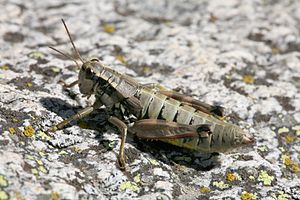Common mountain cricket
| Common mountain cricket | ||||||||||||
|---|---|---|---|---|---|---|---|---|---|---|---|---|

Common mountain cricket ( Podisma pedestris ), ♀ |
||||||||||||
| Systematics | ||||||||||||
|
||||||||||||
| Scientific name | ||||||||||||
| Podisma pedestris | ||||||||||||
| ( Linnaeus , 1758) |
The common mountain insect ( Podisma pedestris ) is a short- antennae insect from the family of field locusts (Acrididae).
features
The males of the common mountain insect are 17 to 19 millimeters long, the females 24 to 30 millimeters. The animals have a red-brown or gray, brownish or yellowish olive, but never green basic color with yellow and black markings. A wide black stripe runs from the compound eyes to the rear edge of the pronotum. The top of the pronotum is dark in front, as are the sides of the abdominal segments. The males have a much more contrasting pattern than the females, which makes their abdomen appear ringed black. The underside of the abdomen is yellow. The thighs ( femora ) of the hind legs are light red on the underside and inside, the splints ( tibiae ) are bluish with white thorns. The wings are severely receded and do not reach the length of the pronotum . However, there are very rarely individuals with fully developed wings.
Occurrence and habitat
The species is Eurasian from the Pyrenees to Mongolia in the Altai Mountains . In Europe it occurs mainly in Scandinavia and in the Alps, but it can also be found on the Balkan peninsula from Bulgaria to the Greek Olympus . In Central Europe, the species is widespread from Alsace to Switzerland and Austria, eastwards in southern and eastern Germany, the Czech Republic and Poland. In Germany the species occurs north of the Danube east of the Schweinfurt – Ingolstadt line and in the Bavarian Alps from Garmisch to the east. The deposits in northern Germany have long been extinct. In the vertical distribution heights of 500 to 2,800 meters are reached.
Warm, dry, rocky and sparsely vegetated slopes with permeable soils such as rubble heaps, stony alpine meadows, forest clearings and dry grasslands are settled. Sometimes they can also be found in bogs .
Way of life
The adult animals can be found from mid-June to mid-November, with the peak in August and September. The animals live on the ground and stay there even in intense sunlight on hot, thinly overgrown rock slabs. They are tolerant of night frost. The common mountain insect feeds on various grasses and herbaceous plants.
The females lay their eggs in the ground and cover them with litter. The ootheca is 9 to 16, on average 11 to 14 millimeters long, at the ends 4.5 to 5.5 millimeters, at the sides 6 to 6.5 millimeters thick and contains 11 to 32 eggs. A single egg is 4.5 to 5.1 millimeters long and 1.2 to 1.5 millimeters thick. The eggs hibernate once or twice before the animals hatch. Five larval stages are passed through.
singing
Both sexes can only crackle gently with their mandibles . During courtship , the male cautiously creeps up and performs rocking movements. If a female reacts and comes closer, the male stops and fixes it, which it otherwise does with other conspecifics. If the female approaches less than 10 centimeters away, the male will jump over it. The male then sits on the female for a long time and, in addition to moving back and forth, also performs regular series of leg movements.
Specialized enemies
The larvae of the nematode Mermis nigrescens develop in the Imagines , the oothecae the larvae of beetles are Zonabris floralis , Mylabris polymorpha , Mylabris quadripunctata and the fly Thyridanthrax fenestratus proven.
Hazard and protection
The species is listed in Germany's Red List of Threatened Species as “Threatened” (Category 1), in the Swiss Red List it is listed as “Not Threatened” (LC) and in the Austrian Red List it is listed as “Endangered “(NT) recorded.
supporting documents
Individual evidence
- ↑ a b c d e f g Peter Detzel: The locusts of Baden-Württemberg . Eugen Ulmer, Stuttgart 1998, ISBN 3-8001-3507-8 , pp. 350 ff .
- ↑ a b c d e f Heiko Bellmann : The cosmos of locust leader. Determine the species of Central Europe with certainty . Franckh-Kosmos, Stuttgart 2006, ISBN 3-440-10447-8 , pp. 200 .
- ↑ a b c d e f g h Bertrand & Hannes Baur, Christian & Daniel Roesti: The locusts of Switzerland . Haupt Verlag, Bern 2006, ISBN 3-258-07053-9 , p. 210 .
- ^ Christian Monnerat, Philippe Thorens, Thomas Walter, Yves Gonseth: Rote Liste Heuschrecken. Red list of endangered species in Switzerland Federal Office for the Environment and Swiss Center for the Cartography of Fauna, Bern, 2007.
- ↑ K. Adlbauer, A. Kaltenbach: Red list of endangered grasshoppers and crickets, catchy tunes , cockroaches and catching horrors. (Saltatoria, Dermaptera, Blattodea, Mantodea) in: J. Gepp (Red.): Red Lists of Endangered Animals Austria , Green Series of the Federal Ministry f. Environment, Youth and Family, Vol. 2, Vienna 1994.
literature
- Bertrand & Hannes Baur, Christian & Daniel Roesti: The locusts of Switzerland . Haupt Verlag, Bern 2006, ISBN 3-258-07053-9 .
- Heiko Bellmann : The Cosmos Locust Leader. Determine the species of Central Europe with certainty . Franckh-Kosmos, Stuttgart 2006, ISBN 3-440-10447-8 .
- Peter Detzel: The locusts of Baden-Württemberg . Eugen Ulmer, Stuttgart 1998, ISBN 3-8001-3507-8 .
